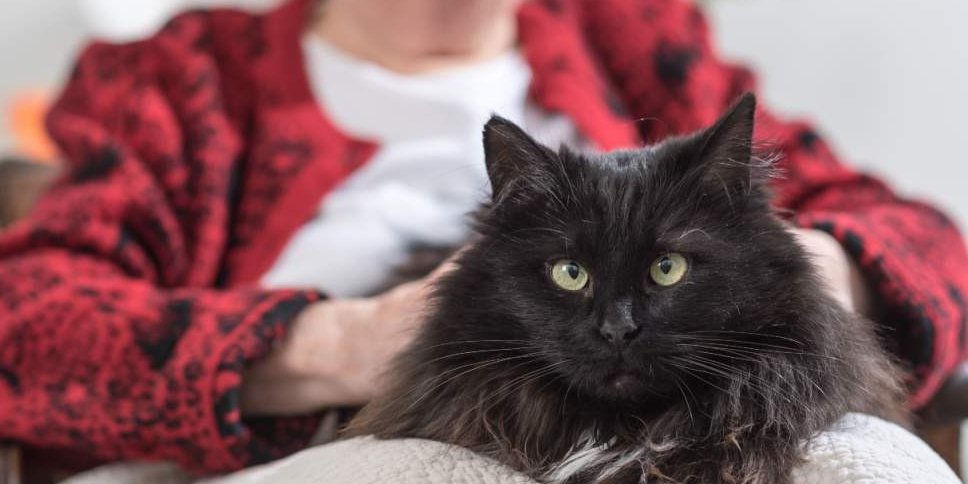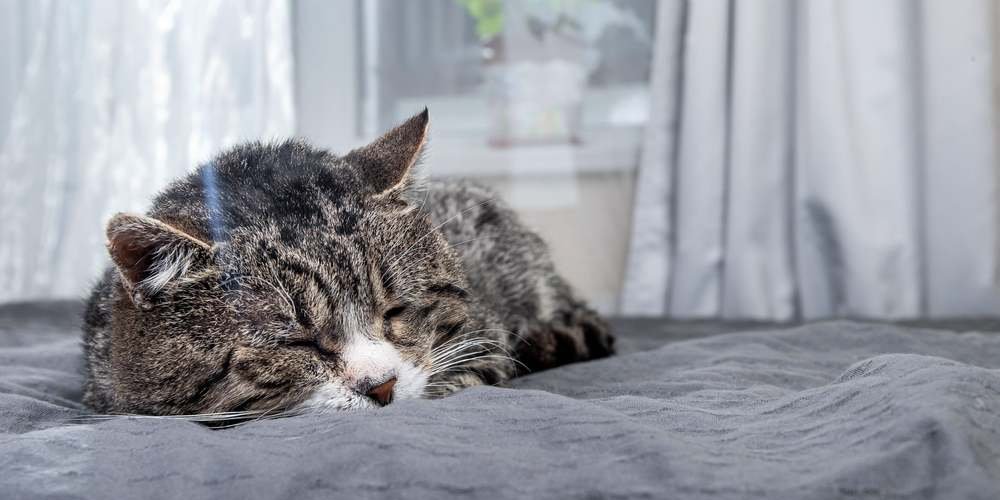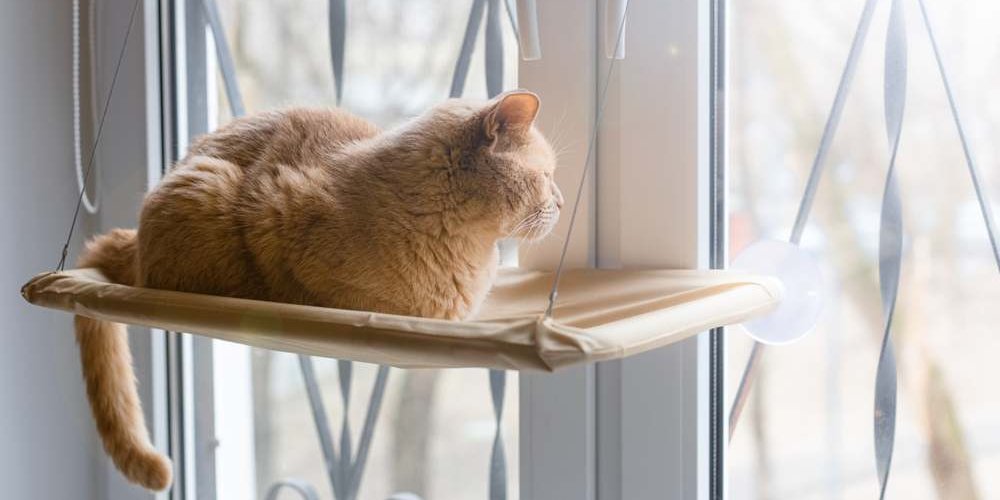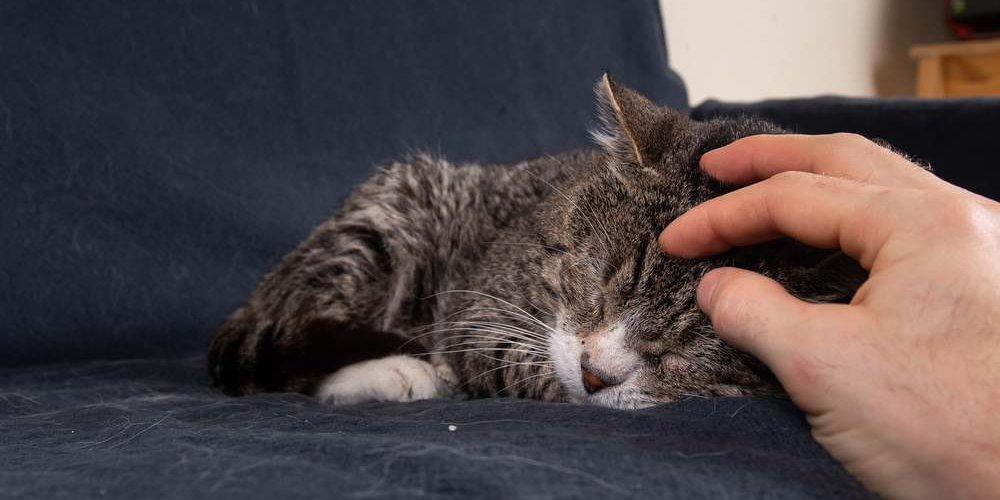
Similar to humans, cats can experience cognitive dysfunction as they age. evrymmnt/Shutterstock.com
Quick Overview: Cognitive Dysfunction Syndrome in Cats
 Other Names: CDS, fCDS, CD, Feline dementia
Other Names: CDS, fCDS, CD, Feline dementia
 Common Symptoms: Disorientation, inappropriate urination/defecation, excessive vocalizing, anxiety, issues with learning and memory
Common Symptoms: Disorientation, inappropriate urination/defecation, excessive vocalizing, anxiety, issues with learning and memory
 Requires Ongoing Medication: Some cats might respond to long-term use of selegiline (L-deprenyl)
Requires Ongoing Medication: Some cats might respond to long-term use of selegiline (L-deprenyl)
 Vaccine Available: No
Vaccine Available: No
 Treatment Options: Environmental enrichment, feline calming pheromone diffusers (Feliway), selegiline (L-deprenyl), anxiety medications, and supplements such as vitamin C, vitamin E, omega fatty acids, and other antioxidant rich nutrients
Treatment Options: Environmental enrichment, feline calming pheromone diffusers (Feliway), selegiline (L-deprenyl), anxiety medications, and supplements such as vitamin C, vitamin E, omega fatty acids, and other antioxidant rich nutrients
 Home Treatment: Avoid behaviors or changes that might induce further confusion or anxiety. Keep items in the home like food bowls and litter boxes in familiar locations. Although frustrating, avoid rash or angry behavior or punishments toward cats with CD as this can increase confusion and stress in the cat.
Home Treatment: Avoid behaviors or changes that might induce further confusion or anxiety. Keep items in the home like food bowls and litter boxes in familiar locations. Although frustrating, avoid rash or angry behavior or punishments toward cats with CD as this can increase confusion and stress in the cat.
Cognitive dysfunction syndrome in cats is a common disorder seen in aging cats. Cats with cognitive dysfunction syndrome might show signs of confusion, disorientation, and undesirable behavior changes, but these symptoms can also have medical causes. In this article, learn what you might see in cats with cognitive dysfunction, how a diagnosis might be approached, and treatment strategies.
What Is Cognitive Dysfunction Syndrome in Cats?
Feline cognitive dysfunction syndrome (CDS) is a condition similar to Alzheimer’s disease in humans. It describes a condition involving age-related changes in a cat’s behavior that cannot be attributed to any other medical condition.
Cats might start to show signs of cognitive dysfunction after 10 years of age.[1] According to studies, nearly 30% of cats between 11 and 14 years of age develop at least one behavioral problem related to cognitive dysfunction. At more than 15 years of age, this value increases to 50% of cats.[2]
There is a lot more known about cognitive dysfunction syndrome in dogs, as well as Alzheimer’s in people. Much of what we know about cats comes from what we already know of these similar syndromes in dogs and people. However, there are some specific characteristics seen in cats.
Symptoms of Cognitive Dysfunction Syndrome in Cats
The symptoms of cognitive dysfunction in cats have been summarized with an acronym, VISHDAAL:[2]
- Excessive Vocalization: Meowing and yowling more often than normal is one of the most reported signs seen. According to one study, more than 60% of cats with CDS showed this sign.[3]
- Alterations in Interactions: This can be any kind of change in the human-cat interaction at home. A cat might appear more needy and demanding. A recent study showed that about 50% of cats with CDS were more affectionate toward their owners and demanded more attention. Conversely, cats might instead spend less time around human family members.
- Changes in Sleep-Wake Cycle: Most commonly, this involves a cat being awake more at night. A cat might appear to pace aimlessly or wander the home. This might be accompanied by excessive vocalization.
- House-soiling: According to veterinary behavior specialists, this is the number one sign of CDS that leads to a behavioral referral. Signs include urinating or defecating outside of the litter box. Anywhere from 30% up to 70% of cats with CDS might show these behaviors.
- Disorientation: This is one of the more classic signs of cognitive dysfunction that is harder to attribute to a separate medical cause. A cat that previously had no issue navigating the home might appear to get confused or even lost. Owners might see pacing and aimless wandering through the home. A cat might be found sitting or resting in a location of the home they would not typically spend time in.
- Alterations in Activity Levels: This might manifest either as increased activity, such as pacing or wandering, or reduced activity, such as more sleeping and resting, and less interest in play behavior.
- Anxiety: Cats with CDS often show signs of increased stress or anxiety. Some of this might stem from disorientation and confusion. Changes in the home environment, alterations in routine, and changes in interactions with family (human and animal) can add to anxiety.
- Learning and Memory: Cats with CDS might appear to forget things. Cat owners describe their cats as seeming to forget they’ve been fed, unable to remember where their food or litter box is located, or even appearing to forget where they were going.
Ruling Out Medical Causes
Diagnosis of cognitive dysfunction syndrome relies on ruling out other medical causes for signs and symptoms being seen at home.
Older cats are often affected by more than one condition, and many medical conditions can contribute to one or more of the same symptoms seen with cognitive dysfunction.
Here are some examples of medical conditions commonly seen in senior cats that can contribute to symptoms also associated with cognitive dysfunction.
- Hypertension
- Kidney disease
- Orthopedic pain/arthritis
- Dental disease
- Neurologic disease
- Urinary tract disease
Veterinarians must first rule out these other causes before determining how much can be attributed to cognitive dysfunction.
Causes of Cognitive Dysfunction Syndrome in Cats

As cats age, the brain can go through many changes that can lead to signs of cognitive dysfunction. Alex Zotov/Shutterstock.com
The exact cause of cognitive dysfunction syndrome in cats is not fully understood, but there are a few theories about changes that occur in the brain that can contribute.[2] Some of this information is translated from what is known about canine cognitive dysfunction and Alzheimer’s disease in people, including:
- Oxidative damage: Oxidative damage describes a process where free radicals (unstable atoms) accumulate in the body and cause damage to body tissues at the cellular level. This process can occur in the brain, leading to tissue damage and degeneration over time.
- Blood flow changes in the brain: Some cats with CDS have been found to have evidence in their brain tissues of tiny hemorrhages or bleeds, blood clots, and even a form of arteriosclerosis (a process commonly associated with heart attacks in people) around blood vessels in the brain. Poor blood flow can lead to brain tissues starving for oxygen and not functioning as well.
- Brain atrophy and neuron loss: An age-related degeneration has been documented in cats. A significant difference in the number of neuron cells has been recorded in cats older than 12 years of age compared with cats 2 to 3 years of age.
- Amyloid-B accumulation: Amyloid-B is a protein that can accumulate in the brain, causing toxicity to nerve cells. Amyloid-B accumulates in people with dementia. There are some differences compared with people and the connections are not well understood, but cats over the age of 10 have been shown to accumulate amyloid-B as well.
- Accumulation of tau protein: Tau protein helps stabilize and protect a part of the brain cell.[4] In humans with Alzheimer’s disease, tau proteins are found to have detached from the portion of the neurons they are supposed to protect and instead accumulate abnormally into structures called neurofibrillary tangles. The research is still early in cats, but some aged cats have been found to contain abnormal tau protein accumulation in their brain cells.[5]
Diagnosing Cognitive Dysfunction in Cats
A diagnosis of cognitive dysfunction syndrome is a diagnosis of exclusion. This means that to determine that CDS is the cause for signs and symptoms seen at home, other medical disorders must be ruled out first. There is no specific test for CDS.
Here are some diagnostic tests veterinarians use and how they may help to rule out some medical causes of signs and symptoms frequently seen with CDS:
- Blood work: Blood work can be used to check for liver and kidney disease, diabetes, internal infections, and hyperthyroid disease.
- Blood pressure: High blood pressure can be seen with diseases like heart disease, kidney disease, and hyperthyroidism.
- X-rays: X-rays (radiographs) can be used to look for signs of joint disease and arthritis, abnormal heart size, bladder stones, and changes to internal organ size and appearance. X-rays are also used during dental procedures to better evaluate the teeth as potential sources of pain.
- Ultrasound: An ultrasound or sonogram can be used to better view organs and tissues inside the body. A specialized ultrasound called an echocardiogram is used to fully evaluate heart function and disease.
- Urinalysis: Collecting a urine sample is important for diagnosing urinary tract infections and assisting with evaluation for kidney disease, diabetes, bladder stones, and feline idiopathic cystitis.
- MRI (magnetic resonance imaging): MRI is the standard for scanning the brain for physical abnormalities. MRI, which requires anesthesia, is usually only available at larger veterinary referral centers or universities. However, without MRI, it can be very difficult to determine if behavioral or neurologic changes are related to a physical lesion in the brain.
With the exception of MRI and advanced ultrasounds, most veterinarians have access to the other testing listed to help narrow down causes of changes you may be seeing in your cat at home.
Treatments for Cognitive Dysfunction in Cats

There is no cure for cognitive dysfunction in cats but certain therapies might slow down the process and provide extra care and support for cats with CDS. Oleg Opryshko / Shutterstock.com
- Environmental enrichment: Providing environmental enrichment with activities that promote play, exploration, problem-solving, and hunting and climbing behaviors contributes to the growth and stimulation of neuron cells in the brain. Window perches, dedicated play time, and interactive/puzzle feeders offer enrichment for cats. Enrichment might also require changes in interactions with the family at home. Many cats with CDS are more needy.
- Environmental modification: For cats with advanced signs of CDS, it can help to keep their environment as stable as possible. Cats showing signs of confusion and disorientation in a larger home (especially at night) may need to be confined to a smaller area of the house with all of their needs and amenities. Cats with night-time anxiety or excessive vocalization may benefit from a night light, soft music or sound machine noise, and calming pheromone diffusers like Feliway.
- Quality Time: Your cat with cognitive dysfunction will want more attention and quality lap time. Many cats with CDS show attention-seeking behaviors, a desire to sleep in bed with owners (if they haven’t before), and extra lap time. Be prepared to modify your own routine to accommodate some of these needs. In homes where owners reject these needs, cats may develop more signs of confusion and anxiety.
- Dietary supplements: Although there are no supplements proven to slow down, stop, or prevent cognitive dysfunction syndrome in cats, some nutrients have demonstrated benefits in both pets and people with similar cognitive dysfunction. Many have antioxidant potential. Some common supplements that may help cats with CDS include:[6]
- S-adenosyl-L-methionine (SAMe) helps keep cell membranes smooth and supple. It also enhances the production of the antioxidant glutathione. It has appeared to help some cats with earlier signs of CDS.
- Melatonin might help with disrupted sleep-wake cycles in some cats.
- L-theanine (Solliquin) is an amino acid that has been shown to provide a sense of calm for some cats.
- Zylkene is a milk protein derivative that might provide a sense of calm.
- Omega-3 fatty acids can counteract inflammation within the body and provide antioxidant action.
- Senilife is approved for use in both cats and dogs, but has only been evaluated in dogs. Its true benefit for cats is not yet clear. It contains Gingko biloba, and vitamins B6 and E, among other ingredients.
- Aktivait contains omega-3, vitamins E and C, L-carnitine, and other ingredients. There is a version of the product made for cats, though it has not been evaluated.
Note: The dog product should not be used on cats, as it contains alpha-lipoic acid, which is toxic to cats. - Joint supplements containing glucosamine, chondroitin, avocado-soybean unsaponifiables (ASU), green-lipped mussel (GLM), and others might benefit cats who need support for arthritis and joint pain.
- Diets: No diets are specifically formulated for cognitive dysfunction in cats. Diets high in antioxidants, omega-3 fatty acids, vitamins C, E, and B12, and L-carnitine might be beneficial for slowing down or counteracting factors that contribute to signs of CDS. Diets containing glucosamine/chondroitin, green-lipped mussel (GLM), and other joint health ingredients might assist those cats with mobility issues. For cats with inappropriate elimination, urinary health diets and prescription diets designed to alter urine pH and assist with the prevention of bladder stone formation and stress-related urinary disorders might help cats experiencing these symptoms as part of CDS.
Medication
- Selegiline is a medication that has a neuroprotective effect and reduces free-radical formation. It is FDA-approved only for dogs to treat canine cognitive dysfunction syndrome, but it can be prescribed to cats off-label by a veterinarian. There have been positive benefits seen based on anecdotal use by individual clinicians.
- Anxiety medications might include medications like fluoxetine (Prozac), clomipramine (Clomicalm), and gabapentin. These can be considerations for cats with a significant anxiety, fear, or stress component to their cognitive dysfunction.
Cat Care Tips

Caring for a cat with cognitive dysfunction is generally aimed at providing support at home that caters to a cat’s individual needs. Alex Zotov / Shutterstock.com
- Provide easy access to food and water bowls and litter boxes, including on multiple levels of the home.
- Expect to give your cat more attention and make yourself more available for quality time. Cats with CDS that are cuddled, especially at night, show fewer signs of agitation and stress.
- Don’t act in an angry or frustrated manner toward a cat showing signs of being confused or needy. This might only aggravate confusion and stress, leading to worsening behavior.
- Environmental enrichment activities should be a part of every cat’s life from very early on but are even more important later in life.
- Don’t assume that cognitive dysfunction is present. Always see your veterinarian for help with ruling out other medical disorders that can cause similar signs and symptoms.
Prevention of Cognitive Dysfunction Syndrome in Cats
There is no proven prevention for cognitive dysfunction in cats. But similar to people with Alzheimer’s disease, enriching activities focused on learning, memory, and problem-solving might help slow down the onset of cognitive dysfunction. Include activities focused on play, hunting, and problem-solving from the earliest days of your cat’s life with you.
An enriching home environment can also help. Provide cat perches, cat trees, and other physical attributes in the home to help develop regular movement, play, and stimulation.
Diets high in antioxidants, omega-3 fatty acids, and other nutrients previously mentioned may also help to slow down the onset of cognitive dysfunction.
Frequently Asked Questions
How long do cats live with cognitive dysfunction?
No studies in cats have looked at life expectancy. Cognitive dysfunction has been found in cats as old as 22 years in studies, suggesting that cats can live a long life with CDS. Some cats develop signs as early as 6 years of age or much later in life.
What is the end stage of dementia in cats?
This varies by case because other medical disorders can affect a cat at the same time. However, severe cognitive dysfunction in a cat may be characterized by constant wandering, getting lost in the home, constant excessive vocalizing, significant appetite decline, agitation, and regular house-soiling behavior.
-
Cognitive dysfunction. (2022, May 16). Cornell University College of Veterinary Medicine.
-
Sordo, L. and Gunn-Moore, D.A. (2021), Cognitive Dysfunction in Cats: Update on Neuropathological and Behavioural Changes Plus Clinical Management. Veterinary Record, 188: N/A-N/A e3.
-
Landsberg, G., Denenberg, S., & Araujo, J. A. (2010). Cognitive Dysfunction in Cats: A Syndrome we Used to Dismiss as ‘Old Age.’ Journal of Feline Medicine and Surgery, 12(11), 837–848. https://doi.org/10.1016/j.jfms.2010.09.004
-
Tau protein and Alzheimer’s disease: What’s the connection? | BrightFocus Foundation. (2023, December 4).
-
What happens to the brain in Alzheimer’s disease? (n.d.). National Institute on Aging.
-
Ms, N. S. D., PhD. (2020, May 21). Unpacking feline dementia: A veterinary guide. DVM 360.








We have an 18 year old we adopted when she was 7, plus 2 torties that are 9 years old (sisters). The 18 year old, named Choya, has always been a talker. The last month or so she has started “yowling,” not her typical meow-talk. She has no other symptoms of CDS. She does sleep more (age?), but she woes attach the various catnip mice we have around every where, scratching posts; activity such as running up and down stairs is very good, jumping up on “her” chairs, dresser, the bed. She gets checked reularly at the ,,vet. I’m concerned that the “yowling” might be the first sign of CDS. Is there a cat food recommendation I could get? She loves salmon, tuna, white fish; chicken or beef mixed with a tuna or samlon pate. Any sugggestions will help. Thank you!
Hi Cynthia,
AT 18 years of age, it’s great that your kitty has not shown too many other apparent signs of cognitive change. The yowling is not specific to cognitive dysfunction but it could certainly be related. Although you mention she goes to the vet regularly, if she has not been in the last few months, especially since this behavior started, it may be a good idea to have a check up. Make sure her vision, weight, heart, and neurologic health appear to be stable.
I cannot provide a specific food recommendation for you. For senior cats, a food choice may be best catered to assisting with one or more existing health concerns. There are some particulars mentioned in the article with suggestions for what to look for in a diet that I hope are helpful.
Thanks Dr. Vanderhoof. Choya was at the doctor’s about 2 months ago and, other than the yowling, nothing has changed in the last two checkups – one every 6 months, excluding this one. Weight has stayed the same, attention span is good still, appetite is very good. No “yowling” for the last 4 days or so. If it starts up again, I will call her vet. Thank you!
Also, my cat with the aggressive behavior is a Tortoise!! Has the Tortatude according to Mr Jackson! Seriously I’m hoping it’s the diet or the new chair my friend gave me who just happened to have a female cat? I’ll get rid of it!!